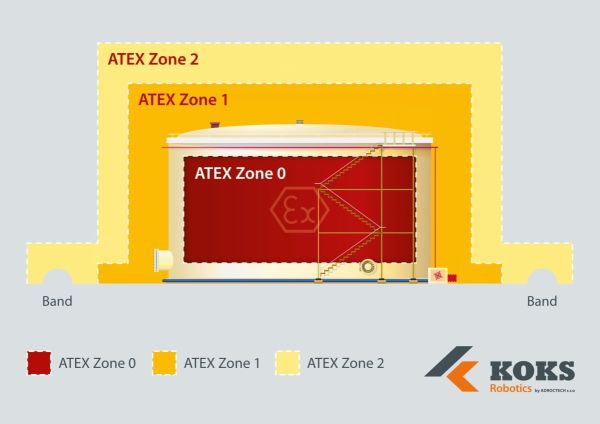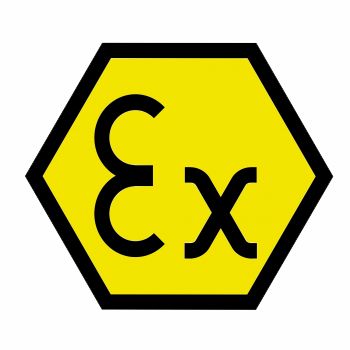- Marketleader in no-man-entry robots
- Game-changing cleaning method
- ATEX zone 0 certified robots
ATEX Certifications
Determine the level of risk associated with explosive atmospheres

Since July 1 2003, electrical equipment used in potentially explosive environments within the European Union must comply with the directive and follow the ATEX standards. ATEX stands for ‘Atmosphères Explosibles’. There are different types of atmospheres: gas, vapours, mists and dust.
ATEX is the European legal regulatory framework that applies within the European Union. It applies tot he manufacture, installation and use of equipment in explosive environments. The ATEX framework refers to two European directives. Using explosion-proof equipment in a potentially hazardous environment is a requirement for both the user and the supplier of the explosion-proof equipment.
Information about ATEX Certifications with regard to tank cleaning robots?
We can imagine that you would like to know more about our KOKS Robotics products, the fields of application and our company. We will be more than willing to tell you why thousands of professionals worldwide trust KOKS Robotics equipment.
Directives
European ATEX legalisation therefore has two different ATEX directives. ATEX Directive 2014/34/EU (also known as ATEX 114/product directive) falls within the scope of CE Marking and applies to the manufacturer/supplier of ATEX equipment. ATEX equipment is built to a level of protection corresponding to the risk.
Directive 1999/92/EC (also known as ATEX 153/Social Directive) applies to sites with hazardous areas. Sites such as chemical plants, oil and gas installations must classify the workplace into hazardous areas depending on the frequency and duration that an explosive atmosphere is present in the form of gas, vapour, mist or dust. Employers must prepare and maintain an Explosion Protection Document (EPD).
Certification body
In order to comply with ATEX directives, it is a legal requirement to engage a third party body. This body is notified by a national government to the European Commission to carry out acts related to a directive known as the ATEX Notified Bodies Group (ExNBG). Also known as an ATEX Notified Body (NB).
Conformity
The European Commission authorises suppliers to sell Ex products in the EU. This is based on the seller’s declaration that the product meets the essential health and safety requirements of the ATEX directive. This declaration is called the EU Declaration of Conformity (DoC). It is a declaration made by the manufacturer of the equipment and delcares, on the manufacturer’s sole responsibility, that they have all the necessary documentation and evidence to comply with the ATEX Directive.
The ATEX directives are required by law for both electrical and non-electrical equipment marketed or sold in the EU that can be used in potentially hazardous environments.
ATEX Zones
Which ATEX zones apply? Why do ATEX zones exist and what are the definitions? The first European directive is ATEX 153 (Directive 1999/92/EC), which requires owners to identify ATEX zones in areas with explosive sources. This zone classification must be included in the Explosion Protection Document (EPD).
The explosion risk is determined on the basis of a risk inventory and evaluation. Seamlessly, we move to the ATEX 114 directive (Directive 2014/34/EU). This directive specifies approved equipment by category, indicates in which zones they can be used, to prevent the equipment from causing ignitions.
Identify ATEX area
An ATEX area is defined by the probability that an explosion may occur. Explosive atmospheres can be created by flammable gases, vapour, mist or dust. When enough of this is present, mixed with atmosphere (oxygen) and an ignition source, it can cause an explosion. The explosion hazard can take the following forms:
- Gas explosion
- Mist explosion
- Dust explosion
ATEX zones for gas or mist explosion hazards are designated ATEX Zone 0, 1 or 2. The ATEX zones for dust explosion hazard are designated ATEX Zone 20, 21 or 22.
The following aspects must be considered when defining ATEX zones:
- Hazardous sources, all points where gas, vapour or dust can potentially break out should be documented.
- The quantities of gas, vapour and dust that can be released should be calculated.
- The probability of a hazardous explosive mixture being present is calculated.

ATEX Zones 0, 1 & 2
ATEX Zone 0:
This is an area where an explosive atmosphere is constantly, for long periods or frequently present. This is created by a mixture of flammable substances in the form of gas, vapour or mist with air. Under normal conditions, there is a high risk of explosion:
- More than 1,000 hours per year.
- >10% of operating hours.
ATEX Zone 1:
This is an area where an explosive atmosphere may occasionally occur during normal operations. This created by a mixture of air and flammable substances in the form of gas, vapour or mist. Under normal conditions, there is an average risk of explosions:
- Between 10 and 1,000 hours per year.
- Between 0.1% and 10% of operating hours.
ATEX Zone 2:
This is an area where an explosive atmosphere is unlikely to be present under normal working conditions. If it does occur, the risk of explosion will persist for a short period only. This is caused by a mixture of flammable substances in the form of gas, vapour or mist with air. Under normal conditions, there is a low risk of explosions:
- Less than 10 hours per year.
- <0.1% of operating hours.

ATEX Zones 20, 21 & 22
ATEX Zone 20:
This is an area where an explosive atmosphere is constantly, for long periods or frequently present in the form of a cloud of combustible dust in the air. Under normal conditions, there is a high risk of explosions:
- More than 1,000 hours per day.
- >10% of operating hours.
ATEX Zone 21:
This is an area where an explosive atmosphere in the form of a cloud of combustible dust in the air may occasionally occur during normal conditions. Under normal conditions, there is an average risk of explosions:
- Between 10 and 1,000 hours per year.
- Between 0.1% and 10% of operating hours.
ATEX Zone 22:
This is an area where there is unlikely to be an explosive atmosphere in the form of a cloud of combustible dust in the air under normal conditions. If this does happen, it will persist for a short period only. Under normal conditions, there is a low risk of explosions:
- Less than 10 hours per year.
- <0.1% of operating hours.
The ATEX directives play a crucial role in ensuring safety of eletrical and non-eletrical equipment used in potentially explosive environments within the European Union. The ATEX zones determine the level of risk associated with explosive atmospheres. Understanding and adhering to these directives and zone classifications are vital for maintaining workplace safety and preventing potential ignition sources.



